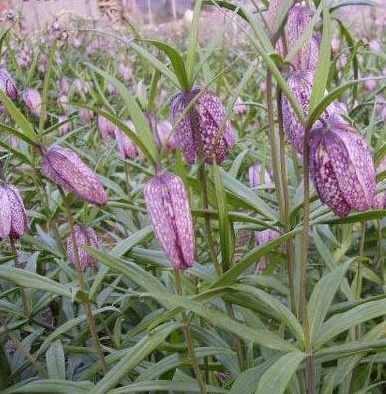- Cough with minimal or difficult to expectorate
sputum due to Fire from Yin deficiency burning the Lungs. Use with
Anemarrhena
asphodeloides- Zhi mu.
[4]
- Dry cough with scanty sputum and dry throat due to Lung deficiency,
[1,2,3]
it is usually used with
Glehnia littoralis-
Glehnia root and
Ophipogon japonicus-
Ophiopogon root.
- Cough and wheezing with copious sputum, with
Prunus
armeniaca- Xing ren.
[4]
- Chronic cough presenting with fatigue, irritability, excessive or bloody sputum,
a stifling sensation and distention in the chest, and lack of appetite, with
Eriobotrya japonica- Pi pa ye,
Ophipogon japonicus- Mai men dong and
Polygonatum odoratum- Yu zhu.
- Painful obstruction of the chest with palpitations and insomnia, with
Polygala
tenuifolia- Yuan zhi,
Poria cocos- Fu ling
and
Trichosanthes kirilowii- Gua
lou.
[4]
- Scofula and abscesses, with
Fritillaria
thunbergii- Zhe bei mu.
[4] [1] Barefoot Doctor's Manual- 1977 Prepared
by the Revolutionary Health Committee of Hunan Province. Original Chinese manual-
Victor W. Sidel. Originally published by Dr Joseph Quin and the Fogarty International
centre, Bethdesda (1974). Madrona Publishers Seattle Washington ISBN 0-914842-52-8
[2] A Complete English Dictionary of Medicinal Terms in Chinese Acupuncture
and Herbalism 1981- Henry Lu Chinese Foundations of Natural Health- The Academy
of Oriental Heritage, Vancouver, Canada.
[3] The Chinese Materia Medica A practical English- Chinese Library of Traditional
Chinese Medicine Publishing House of Shanghai University of Traditional Chinese
Medicine. Director Hu Ximing ISBN 7-81010-111-X/R-110
[4]
Chinese Herbal Medicine Materia Medica- Dan Bensky and Andrew Gamble-
Eastland Press 1986 Seattle Washington ISBN 0-939616-15-7
Images
1.
zhanjo.sell.everychina.com
2.
commons.wikimedia.org
by Nianahsiwgoa CC S-A 3.0 Unported
Fritimine, chinpeimine.[1]
References
[1] Chinese Herbal Medicine Materia Medica- Dan Bensky and Andrew Gamble-
Eastland Press 1986 Seattle Washington ISBN 0-939616-15-7
 Fritillaria
cirrhosa. F. roylei 川
贝 母
Chuān
bèi mǔ Sichuan fritillary, Tendrilled
Fritillary, Imperial Fritillary
Fritillaria
cirrhosa. F. roylei 川
贝 母
Chuān
bèi mǔ Sichuan fritillary, Tendrilled
Fritillary, Imperial Fritillary